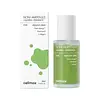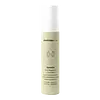What's inside
What's inside
 Key Ingredients
Key Ingredients

 Benefits
Benefits

 Concerns
Concerns

No concerns
 Ingredients Side-by-side
Ingredients Side-by-side

Water
Skin ConditioningButylene Glycol
HumectantPropanediol
SolventGlycerin
Humectant1,2-Hexanediol
Skin ConditioningMorinda Citrifolia Fruit Extract 0.7%
Skin ConditioningSodium Polyacryloyldimethyl Taurate
Emulsion StabilisingDiethoxyethyl Succinate
SolventAllantoin
Skin ConditioningOctyldodeceth-16
EmulsifyingDipropylene Glycol
HumectantMelia Azadirachta Leaf Extract
Skin ConditioningSodium Hyaluronate
HumectantEthylhexylglycerin
Skin ConditioningAdenosine
Skin ConditioningDisodium EDTA
Panthenol
Skin ConditioningGlyceryl Polymethacrylate
Melia Azadirachta Flower Extract
Skin ConditioningMorinda Citrifolia Seed Oil
Skin ConditioningHydrogenated Lecithin
EmulsifyingTheobroma Cacao Seed Extract
AntioxidantRosmarinus Officinalis Leaf Oil
MaskingDextrin
AbsorbentCetearyl Olivate
Sorbitan Olivate
EmulsifyingSucrose Palmitate
EmollientCitrus Reticulata Peel Extract
Skin ConditioningOlea Europaea Fruit Oil
MaskingMacadamia Integrifolia Seed Oil
Skin ConditioningVitis Vinifera Seed Oil
EmollientSimmondsia Chinensis Seed Oil
EmollientSoluble Collagen
HumectantTocopherol
AntioxidantWater, Butylene Glycol, Propanediol, Glycerin, 1,2-Hexanediol, Morinda Citrifolia Fruit Extract 0.7%, Sodium Polyacryloyldimethyl Taurate, Diethoxyethyl Succinate, Allantoin, Octyldodeceth-16, Dipropylene Glycol, Melia Azadirachta Leaf Extract, Sodium Hyaluronate, Ethylhexylglycerin, Adenosine, Disodium EDTA, Panthenol, Glyceryl Polymethacrylate, Melia Azadirachta Flower Extract, Morinda Citrifolia Seed Oil, Hydrogenated Lecithin, Theobroma Cacao Seed Extract, Rosmarinus Officinalis Leaf Oil, Dextrin, Cetearyl Olivate, Sorbitan Olivate, Sucrose Palmitate, Citrus Reticulata Peel Extract, Olea Europaea Fruit Oil, Macadamia Integrifolia Seed Oil, Vitis Vinifera Seed Oil, Simmondsia Chinensis Seed Oil, Soluble Collagen, Tocopherol
Water
Skin ConditioningGlycerin
HumectantCaprylic/Capric Triglyceride
MaskingSimmondsia Chinensis Seed Oil
EmollientMethyl Glucose Sesquistearate
EmollientPanthenol
Skin ConditioningCetyl Ricinoleate
EmollientTrehalose
HumectantCetearyl Alcohol
EmollientGlyceryl Stearate
EmollientPentylene Glycol
Skin ConditioningCeramide NP
Skin ConditioningCeramide AP
Skin ConditioningCeramide EOP
Skin ConditioningPhytosphingosine
Skin ConditioningCholesterol
EmollientZinc PCA
HumectantLinoleic Acid
CleansingZinc Hydrolyzed Hyaluronate
HumectantLactoferrin
Skin ConditioningSodium Polyglutamate
HumectantMadecassoside
AntioxidantAsiaticoside
AntioxidantLactobacillus Ferment
Skin ConditioningCentella Asiatica Leaf Extract
Skin ConditioningLinolenic Acid
CleansingSodium Hyaluronate
HumectantCellulose
AbsorbentTocopherol
AntioxidantHelianthus Annuus Seed Oil
EmollientMaltodextrin
AbsorbentBehenic Acid
CleansingPolyglyceryl-10 Stearate
Skin ConditioningSodium Cetearyl Sulfate
CleansingTriethyl Citrate
MaskingSodium Levulinate
Skin ConditioningPotassium Sorbate
PreservativeXanthan Gum
EmulsifyingTetrasodium Glutamate Diacetate
Polyglyceryl-6 Behenate
Emulsion StabilisingPhenoxyethanol
PreservativeSodium Hydroxide
BufferingWater, Glycerin, Caprylic/Capric Triglyceride, Simmondsia Chinensis Seed Oil, Methyl Glucose Sesquistearate, Panthenol, Cetyl Ricinoleate, Trehalose, Cetearyl Alcohol, Glyceryl Stearate, Pentylene Glycol, Ceramide NP, Ceramide AP, Ceramide EOP, Phytosphingosine, Cholesterol, Zinc PCA, Linoleic Acid, Zinc Hydrolyzed Hyaluronate, Lactoferrin, Sodium Polyglutamate, Madecassoside, Asiaticoside, Lactobacillus Ferment, Centella Asiatica Leaf Extract, Linolenic Acid, Sodium Hyaluronate, Cellulose, Tocopherol, Helianthus Annuus Seed Oil, Maltodextrin, Behenic Acid, Polyglyceryl-10 Stearate, Sodium Cetearyl Sulfate, Triethyl Citrate, Sodium Levulinate, Potassium Sorbate, Xanthan Gum, Tetrasodium Glutamate Diacetate, Polyglyceryl-6 Behenate, Phenoxyethanol, Sodium Hydroxide
 Reviews
Reviews

Ingredients Explained
These ingredients are found in both products.
Ingredients higher up in an ingredient list are typically present in a larger amount.
Glycerin is already naturally found in your skin. It helps moisturize and protect your skin.
A study from 2016 found glycerin to be more effective as a humectant than AHAs and hyaluronic acid.
As a humectant, it helps the skin stay hydrated by pulling moisture to your skin. The low molecular weight of glycerin allows it to pull moisture into the deeper layers of your skin.
Hydrated skin improves your skin barrier; Your skin barrier helps protect against irritants and bacteria.
Glycerin has also been found to have antimicrobial and antiviral properties. Due to these properties, glycerin is often used in wound and burn treatments.
In cosmetics, glycerin is usually derived from plants such as soybean or palm. However, it can also be sourced from animals, such as tallow or animal fat.
This ingredient is organic, colorless, odorless, and non-toxic.
Glycerin is the name for this ingredient in American English. British English uses Glycerol/Glycerine.
Learn more about GlycerinPanthenol is a common ingredient that helps hydrate and soothe the skin. It is found naturally in our skin and hair.
There are two forms of panthenol: D and L.
D-panthenol is also known as dexpanthenol. Most cosmetics use dexpanthenol or a mixture of D and L-panthenol.
Panthenol is famous due to its ability to go deeper into the skin's layers. Using this ingredient has numerous pros (and no cons):
Like hyaluronic acid, panthenol is a humectant. Humectants are able to bind and hold large amounts of water to keep skin hydrated.
This ingredient works well for wound healing. It works by increasing tissue in the wound and helps close open wounds.
Once oxidized, panthenol converts to pantothenic acid. Panthothenic acid is found in all living cells.
This ingredient is also referred to as pro-vitamin B5.
Learn more about PanthenolThis oil comes from the seeds of the desert shrub called Jojoba. It is more commonly known as jojoba oil, a non-comedogenic oil.
Jojoba oil does not contain fragrance and has many fatty-acids, making it a great soothing ingredient.
It also contains Vitamin E, a great moisturizing ingredient. Vitamin E is also an antioxidant and protects your skin against oxidative damage.
This ingredient humectant properties, meaning it helps draw moisture from the air. This helps keep your skin hydrated.
While jojoba has antibacterial properties, it is only able to kill some strains of bacteria.
Studies also show it helps in wound healing. In fact, Indigenous cultures have used jojoba as a moisturizer and to help treat burns for centuries.
Fun fact: Jojoba oil similar to natural human skin sebum, so it has a great effect on dry skin. It is also promising with helping to regulate sebum production.
Due to its fatty acid content, Jojoba oil may not be fungal acne safe. We recommend speaking with a professional if you have any concerns.
Learn more about Simmondsia Chinensis Seed OilSodium Hyaluronate is hyaluronic acid's salt form. It is commonly derived from the sodium salt of hyaluronic acid.
Like hyaluronic acid, it is great at holding water and acts as a humectant. This makes it a great skin hydrating ingredient.
Sodium Hyaluronate is naturally occurring in our bodies and is mostly found in eye fluid and joints.
These are some other common types of Hyaluronic Acid:
Learn more about Sodium HyaluronateTocopherol (also known as Vitamin E) is a common antioxidant used to help protect the skin from free-radicals and strengthen the skin barrier. It's also fat soluble - this means our skin is great at absorbing it.
Vitamin E also helps keep your natural skin lipids healthy. Your lipid skin barrier naturally consists of lipids, ceramides, and fatty acids. Vitamin E offers extra protection for your skin’s lipid barrier, keeping your skin healthy and nourished.
Another benefit is a bit of UV protection. Vitamin E helps reduce the damage caused by UVB rays. (It should not replace your sunscreen). Combining it with Vitamin C can decrease sunburned cells and hyperpigmentation after UV exposure.
You might have noticed Vitamin E + C often paired together. This is because it is great at stabilizing Vitamin C. Using the two together helps increase the effectiveness of both ingredients.
There are often claims that Vitamin E can reduce/prevent scarring, but these claims haven't been confirmed by scientific research.
Learn more about TocopherolWater. It's the most common cosmetic ingredient of all. You'll usually see it at the top of ingredient lists, meaning that it makes up the largest part of the product.
So why is it so popular? Water most often acts as a solvent - this means that it helps dissolve other ingredients into the formulation.
You'll also recognize water as that liquid we all need to stay alive. If you see this, drink a glass of water. Stay hydrated!
Learn more about Water